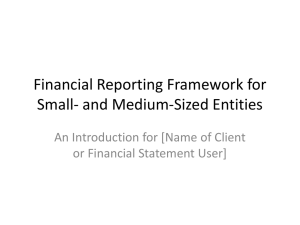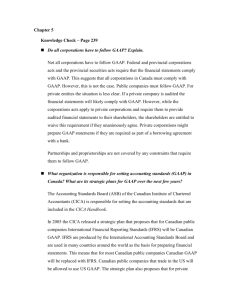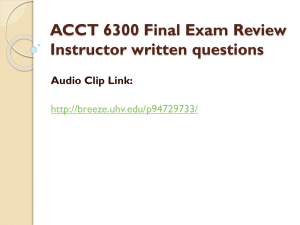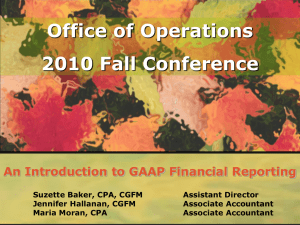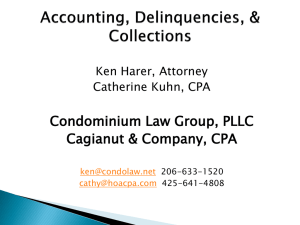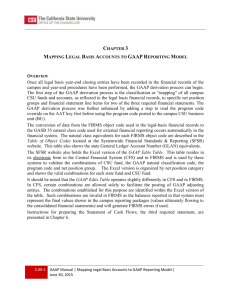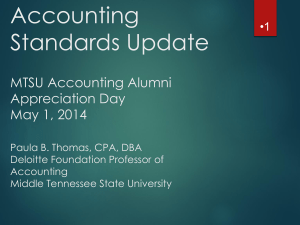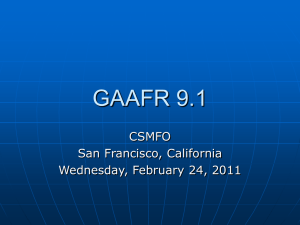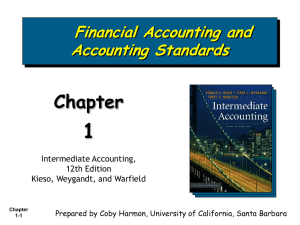modified cash basis
advertisement
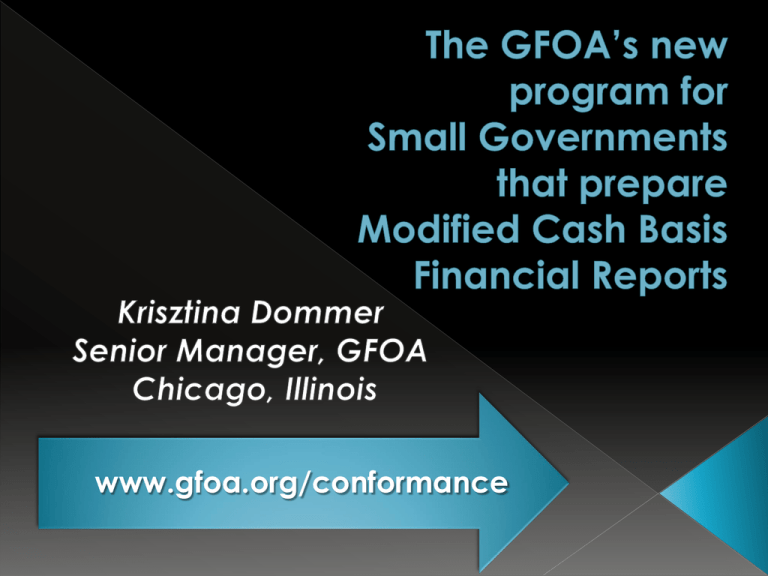
www.gfoa.org/conformance 2008 Research Report by the Government Accounting Standards Board (GASB) › In summary, thousands upon thousands of small governments use a basis of accounting other than GAAP in their audited and published annual financial reports. GAAP is comprehensive, informative, and results in easily understandable and comparable financial statements. › So, why would a government choose to use a different basis of accounting other than generally accepted accounting principles? Perceived complexity Certificate of Conformance Program encourages a presentation closer to GAAP but on a less complex basis of accounting (i.e., modified cash basis). Cost of “once a year” financial report preparation › Smaller/less qualified accounting staff › Complexity of GAAP requirements The Certificate of Conformance Program’s additional requirements are simple and easy to implement with guidelines provided in a preparer checklist and the availability of a sample Small Government Annual Financial Report (SGAFR). Timely financial reporting The Certificate of Conformance Program encourages timeliness of reporting with deadlines that will normally fall six months after the fiscal year end of the government. In the first year of the award program, allowances will be made for more time. A different measure of financial position. › Full cost of services not presented. › Not all assets and liabilities are reported. May not satisfy certain users. › Rating agencies, creditors, investors, taxpayers, and officials . Financial decisions can be problematic. › Determination of cost of services, rate-setting, and balancing the budget. Financial position and results of operations can be more easily manipulated. GAAP financial reporting is not contractually or legally required. Internal and external users understand the cash (modified cash) presentation and its limitations but still find it relevant for their needs. Entity does not have the skills, knowledge, or experience (SKE) to prepare GAAP financial statements. It is cost-effective. The entity is required or permitted by law or regulation to prepare financial statements using a special purpose framework for financial reporting. Authoritative and Nonauthoritative Resources for Cash Basis Financial Statements No real authoritative standards in U.S. for cash or modified cash basis “accounting principles.” Some limited authoritative AICPA audit standards related to cash or modified cash basis statements – specifically AU-C Section 800 – Special Purpose Frameworks. Non-authoritative guidance is available in the form of the AICPA Practice Aid – Applying OCBOA in State and Local Government Financial Statements (www.cpa2biz.com, product code APAOCBO12P). Financial reporting frameworks other than GAAP are identified in AICPA AUSection 800 as one of the following bases: › › › › › Cash basis Tax basis Regulatory basis Other basis Contractual basis Commonly referred to as Other Comprehensive Bases of Accounting (OCBOA) Cash basis › Tax basis › A basis of accounting the entity uses to comply with the requirements or financial reporting provisions of a regulatory agency to whose jurisdiction the entity is subject Contractual basis › A basis of accounting that the entity uses to file its tax return for the period covered by the financial statements Regulatory basis › A basis of accounting that the entity uses to record cash receipts and disbursements and modifications of the cash basis having substantial support A basis of accounting that the entity uses to comply with an agreement between the entity and one or more third parties other than the auditor Other basis › A basis of accounting that uses a definite set of logical, reasonable criteria that is applied to all material items appearing in the financial statements New Professional Recognition Program for Small Government Annual Financial Reports Professional recognition program designed to help small governments that, for practical considerations, do not prepare financial statements in conformity with generally accepted accounting principles (GAAP) improve the quality of their annual financial reports. Uniform guidelines Quality and consistency Stairway to GAAP Ownership and pride Improve the quality and consistency of small government annual financial reports by: › Providing guidelines to help standardize the format and content of annual financial reports prepared on a modified cash basis, › Encouraging governments to follow those guidelines by offering public recognition to those that successfully do so, and › Assisting governments to implement the guidelines by providing technical materials and training. The Certificate of Conformance Program › Encourages compliance with the basic norms of sound financial reporting in situations where GAAP financial reporting is not practical. The Certificate of Achievement Program › Recognizes outstanding achievement in financial reporting, which presupposes financial reporting in conformity with GAAP. For some governments, participation in the Certificate of Conformance Program may be a first step toward GAAP financial reporting and participation in the Certificate of Achievement Program. Any type of government Primary government revenues ≤ $25 million either for: › Current year, or › Average of the five most recent years Where GAAP financial report is › Not required and › Not prepared at any time in the most recent five years Program report referred to as a small government annual financial report (SGAFR) rather than a comprehensive annual financial report (CAFR). › Includes both an introductory section and a financial section. › Not required to include a statistical section. Five-year trend tables are prescribed to provide similar information. Accepting applications for the fiscal year that ended June 30, 2012, and after. › June 30, 2012, report submissions should be received by no later than May 31, 2013. › The normal deadline will be six months following the fiscal year end of the government submitting a report. Allowances will be made during the first year of the award program giving submitters an additional five months. › A complete list of deadlines can be found on the GFOA’s web page for the program. Reports to be judged by combination of › Volunteer reviewers › GFOA professional staff Available on GFOA website (www.gfoa.org/conformance) › Checklists General purpose local governments School districts Stand-alone business-type activities › Sample Small Government Annual Financial Report Example of an award-winning report for preparers to model. Basic fee structure Total Revenues GFOA Member Fee Nonmember Fee Under $1 million $290 $580 $1-10 million $370 $740 Over $10 million $435 $870 Nonmembers that submit for the first time receive a GFOA membership that allows them to submit at the member rate. Grade assigned to each section of the report. Specific comments and suggestions for improvement. › Access to GFOA professional staff for guidance If the report meets the program’s criteria, › Plaque and press release, › A complete list of all award-winning reports maintained on the GFOA’s website, and for › First-time winners of the award, an announcement in the GFOA Newsletter. Results within six months of receiving a submission, which provides adequate time to implement comments and suggestions. Plain vanilla cash basis › Limited to the reporting of cash and cash equivalents and changes therein. Modified cash basis › Modifications to cash receipt and disbursement transactions or events only. › Modifications should have substantial support in GAAP or other accounting literature and be logical. Such as recording interfund receivables and payables resulting from cash transactions or events. Modifications that result in cash inflows and outflows providing a future benefit or obligation being spread out over multiple accounting periods. › Reporting an interfund cash advance to be repaid in future periods as an asset by the lending fund (a future cash benefit) and a liability by the receiving fund (a future cash obligation). NOT recording certain elements on a cash basis and other elements on a full GAAP basis. Modifications to record investments arising from cash transactions does not mean those investments should be adjusted for changes in fair value pursuant to GAAP. › Accruals or non-cash transactions are NOT recorded. › Only cash (and cash equivalents) and items that involve the receipt or disbursement of cash (or cash equivalents) during the period should be recognized, except: › Interfund balances, › Assets that normally convert to cash or cash equivalents, and › Liabilities for cash (or cash equivalents) held on behalf of others, held in escrow, or received in advance of being earned or meeting eligibility requirements Regulatory Basis › The financial statements are prepared on the regulatory basis of accounting as prescribed by Arkansas Code. The regulatory basis differs from accounting principles generally accepted in the United States of America. Revenues are recognized as soon as they are both measureable and available. Revenues are considered to be available when they are collectible within the current period or soon enough thereafter to pay liabilities of the current period. For this purpose, the government considers revenues to be available if they are collected within 60 days of the end of the current period. Expenditures generally are recorded when a liability is incurred. However, debt service expenditures, as well as expenditures related to compensated absences and claims and judgments, are recorded only when payment is due. As a result of this regulatory basis of accounting, capital assets and long-term debt are not recorded in these financial statements. Trend Data AU-C Section 800, Exhibit B › If GAAP set forth requirements that apply to the presentation of financial statements, then cash and modified cash basis financial statements may either comply with those requirements or provide information that communicates the substance of those requirements. › GASB presentation requirements generally apply, in substance, to cash and modified cash basis basic financial statements of state and local governments issuing a complete set of financial statements (i.e., government-wide and fund financial statements). The program requirements for the letter of transmittal combine the suggestions for the letter of transmittal found in a CAFR and some of the requirements for management’s discussion and analysis (MD&A) from GAAP guidance. › › Basic letter of transmittal discussion (GAAFR text) Formal transmittal of report Profile of government Local economy Acknowledgements Condensed financial data Narrative analysis of governmentwide results Narrative analysis of major fund results Narrative analysis of general fund budget results, if applicable. MD&A-type discussion topics Currently no narrative introduction or analysis whatsoever 1. Add narrative “letter of transmittal” with elements from GAAP MD&A and GFOA recommended topics for the letter of transmittal. Create an organizational chart that demonstrates the structure of your entity › Formatting is up to your discretion Compile a list of officials in place either at the time the report was issued or during the fiscal year of the report (if different). › Formatting is up to your discretion. Requirements of GAAP for basic financial statement presentation, but applied in a manner consistent with a modified cash basis and program requirements. › Basic financial statements consistent with GAAP but reported on a modified cash basis. › Possible combination of government-wide and fund financial statements. Same modified cash basis for presenting data in both › Budgetary comparisons for the general fund and major special revenue funds with legally adopted annual (or biennial) budgets must be presented as a basic financial statement. Total Column By definition, not required for reports not presented in accordance with GAAP. Program requirements › Budgetary comparisons for the general fund and major special revenue funds with legally adopted annual (or biennial) budgets (normally reported as RSI in GAAP) must be presented as a basic financial statement. › Certain relevant information normally required to be presented as part of management’s discussion and analysis (MD&A) in connection with GAAP financial reports must be incorporated into the letter of transmittal. Since required supplementary information is only required by GAAP, this removes the option of presenting budgetary comparisons for the general fund and major special revenue funds as either basic financial statements or separately in the RSI. › Thus, the Certificate of Conformance Program Policy requires that budgetary comparisons for the general fund and major special revenue funds be presented as basic financial statements. Local regulatory basis report is already presented in this way. Similar to those required by GAAP if relevant to any of the items recognized under the modified cash basis. Other note disclosures related to matters not presented on the face of the financial statements, as considered necessary or required by the program guidelines. Same disclosures for the summary of significant accounting policies, when applicable to the modified cash basis. Not required to disclose capital assets. Program policy requires a disclosure for long-term liabilities. › Debt, compensated absences, claims and judgments, and pension-related liabilities. List of debt, when it was issued and for what purpose. Changes from the previous year’s balance (increases and decreases). Debt service payments for the next five years and in five-year increments thereafter. Local regulatory basis report already discloses liabilities. The only thing missing is the changes in balances. Otherwise, similar to typical disclosures, when applicable to the modified cash basis. Program requirements › Combining and individual fund financial statements and schedules Including budgetary comparisons presented at the legal level of budgetary control for all individual governmental funds with legally adopted annual or biennial budgets. Program requirements cont. › Schedules of five-year trend data, as applicable: Net position – government-wide financial statements – modified cash basis, Changes in net position – government-wide financial statements – modified cash basis, Fund balances – governmental funds – modified cash basis, Revenues, expenditures, and changes in fund balances – governmental funds – modified cash basis, and Outstanding debt by type Krisztina Dommer Senior Manager Government Finance Officers Association 312-578-5469 Kdommer@gfoa.org
